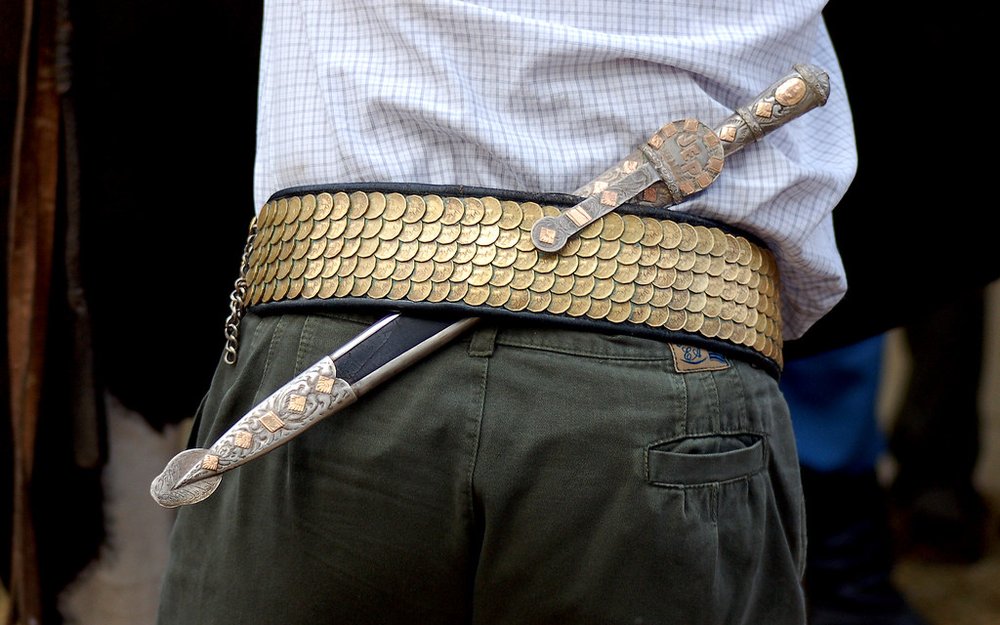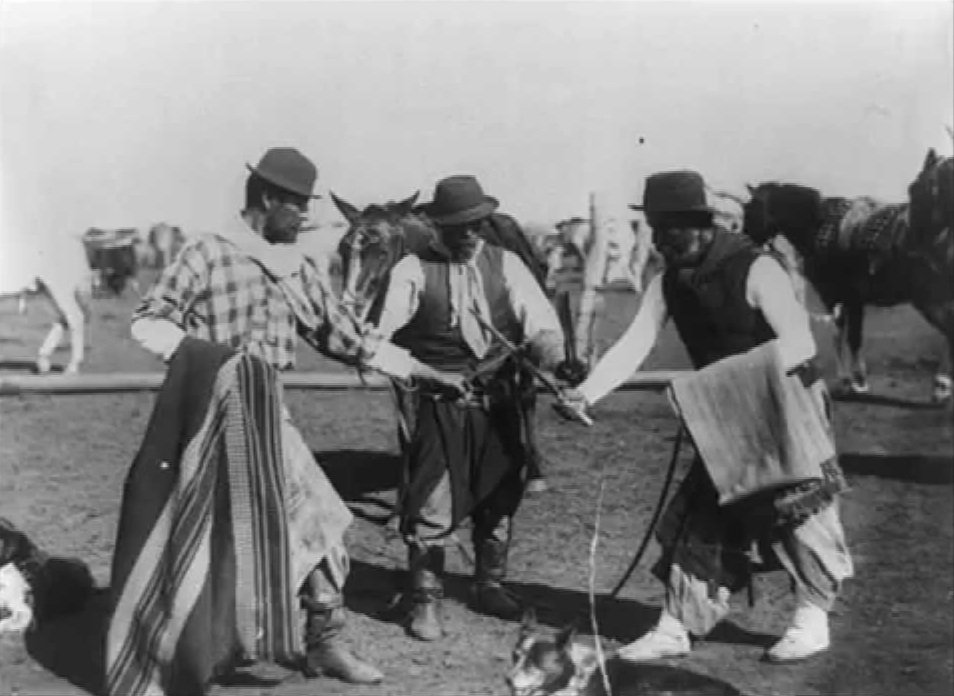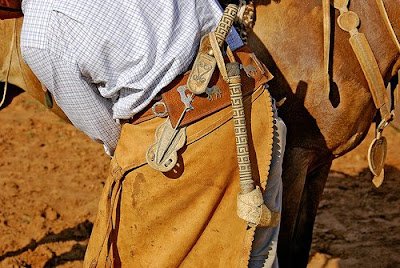The facón knife is believed to have originated in the 19th century with the gaucho cowboys who populated the plains of Argentina. The knife was first used as a tool for herding and hunting, but soon it became an indispensable part of everyday life. It was used not only to cut meat but also for self-defense and other tasks. Over time, it became an iconic symbol of Argentine culture and heritage. The facón knife has evolved over time to become a multifunctional tool that can be used for many purposes. Initially, it was a simple one-edged blade with a wooden handle made from local materials such as cattle horns or bone. Today, however, it is typically made from stainless steel with bones, horns, wood. alpaca and tientos handles.
The facón knife has been deeply embedded in traditional Argentine culture for centuries and continues to play an important role today. It is viewed as a symbol of strength, courage, and honor which is why it is often given as a gift or reward for bravery or achievement. In addition to being used as a tool, it has also become an emblem of national pride and identity with some even referring to it as “the soul of Argentina”.
CHARACTERISTICS OF THE FACÓN KNIFE
The facón Gaucho knife is a traditional Argentine tool that has been used for centuries as a utility, for cutting meat, and for self-defense. It is typically made with a long single-edged blade, with an exposed tang at the end of the handle. The handle is usually composed of two pieces joined together and can be made from a variety of materials such as wood, ivory, brass, leather, or horn. The blade length can vary from 7 to 11 inches and can often have decorative etchings on both sides.
Facón Gaucho knives are typically constructed from steel but other materials may also be used. Common materials include stainless steel, carbon steel and damasco steel depending on the desired strength and durability of the knife (you can learn more about the characteristics of the different materials of the blades by clicking here) Other materials like wood, ivory, brass, leather, or horn may also make up part of its construction for aesthetic purposes.
UNIQUE FEATURES OF THE FACÓN KNIFE
Some of the unique features of the facón knife include:
Blade: The primary feature that makes a facón knife stand out is its distinctive blade, which is typically between six and twelve inches long. It has a straight or slightly curved shape, with a tip that is sharpened to a point. The blade can be made from different types of steel, such as stainless steel, carbon steel, or Damascus steel.
Handle: The handle of the facón knife is usually made from hardwood or bone, although some have handles crafted with silver or gold inlay. This helps to make the knife even more comfortable and easy to use, as well as providing an attractive aesthetic design.
Sheath: A sheath for the facón is also a typical component of this type of knife. This sheath helps protect both the user and the blade, ensuring that it will remain sharp for longer periods of time without being exposed to too much wear and tear.
Versatility: The facón can be used for many different tasks including cutting meat, slicing vegetables, opening packages, and even self-defense if necessary; making it incredibly versatile in comparison to other knives on the market today.
Durable Construction: Its robust construction ensures that it can withstand tough conditions with ease and continue providing excellent performance over many years of use when maintained properly and handled with care.
Ergonomic Design: The design of this type of knife emphasizes ergonomics; allowing users to comfortably grip it while cutting during long periods without experiencing fatigue or pain in their hands despite prolonged usage.
Tradition: Last but not least, perhaps one of the most important aspects that differentiate this type of knife from others around the world is its historical significance; representing centuries-old Argentine heritage and tradition dating back hundreds of years ago until modern times.
USES OF THE FACÓN KNIFE
The facón knife has a long history of serving many traditional uses in Argentina. It was initially used to butcher and prepare large game animals, such as oxen and cows, for food. The razor-sharp edge and curved handle allowed gauchos to make quick work of cutting through tough hides and muscle tissue.
This same sharpness also made it an effective weapon, which was important given the often dangerous nature of the landscape through which the gauchos were accustomed to travelling. In addition, the facon knife was historically used symbolically among the gauchos, who carried it on their backs in their leather belts to signify honour, strength and courage.
MODERN USES OF THE FACÓN KNIFE
Today, the facón knife is still widely used for its original purpose of preparing game meat for consumption. However, its applications have expanded significantly over time with modern improvements in the knife’s structure and materials. For example, it’s been used for:
Cooking: The Facón knife is a great tool for everyday cooking, from slicing and dicing vegetables to preparing meats and other proteins. Its curved blade gives it increased leverage when cutting through tough materials, making it ideal for any task in the kitchen. Additionally, its compact size makes it easy to store and transport, making it an invaluable tool for anyone who enjoys cooking or camping outdoors.
Self-Defense: Although self-defense is not the primary use of the Facón knife, its sharp blade can be used as a deterrent against potential attackers if necessary. Its small size also makes it relatively easy to conceal on one’s person while still providing them with adequate protection should they find themselves in a dangerous situation.
Woodworking: The curved blade of the Facón knife is perfect for carving wood into decorative pieces of art or useful items such as bowls and spoons. It is a great way to hone one’s crafting skills while also creating beautiful pieces that can be enjoyed by many people.
Gardening: This traditional tool makes gardening much easier due to its curved blade which allows for more precise cuts when trimming hedges or pruning trees and bushes. Additionally, its smaller size allows for easier maneuverability when digging or planting seeds in tight spots.
Crafting Leather Goods: The Facón knife is perfect for crafting leather goods such as wallets and belts due to its sharpness which allows users to make precise cuts with minimal effort while working with this versatile material. This versatility makes it a great choice for both beginning and experienced leather crafters alike.
Hunting: Hunters have been using the Facón knife throughout Argentina’s history in order to field dress game so that they can be transported home without spoiling quickly after being taken down by hunters looking for food or sport alike. Its curved blade is perfect for skinning animals quickly and efficiently, giving hunters what they need without leaving behind too much damage on their prey’s body or hide.
THE POPULARITY OF THE FACÓN KNIFE AMONG ARGENTINE GAUCHOS


